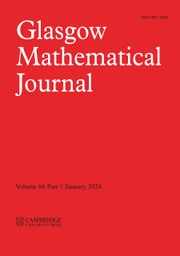No CrossRef data available.
Article contents
A hyperbolic free-by-cyclic group determined by its finite quotients
Part of:
Special aspects of infinite or finite groups
Structure and classification of infinite or finite groups
Published online by Cambridge University Press: 04 April 2025
Abstract
We show that the group  $ \langle a,b,c,t \,:\, a^t=b,b^t=c,c^t=ca^{-1} \rangle$ is profinitely rigid amongst free-by-cyclic groups, providing the first example of a hyperbolic free-by-cyclic group with this property.
$ \langle a,b,c,t \,:\, a^t=b,b^t=c,c^t=ca^{-1} \rangle$ is profinitely rigid amongst free-by-cyclic groups, providing the first example of a hyperbolic free-by-cyclic group with this property.
Information
- Type
- Research Article
- Information
- Copyright
- © The Author(s), 2025. Published by Cambridge University Press on behalf of Glasgow Mathematical Journal Trust
References
Baumslag, G., Residually finite groups with the same finite images,
Compos. Math. 29 (1974), 249–252.Google Scholar
Bridson, M. R. and Grunewald, F. J., Grothendieck’s problems concerning profinite completions and representations of groups, Ann. Math. 160(1) (2004), 359–373.CrossRefGoogle Scholar
Bridson, M. R., McReynolds, D. B., Reid, A. W. and Spitler, R., Absolute profinite rigidity and hyperbolic geometry, Ann. Math. 192(3) (2020), 679–719.Google Scholar
Bogopolski, O., Martino, A. and Ventura, E., The automorphism group of a free-by-cyclic group in rank 2, Comm. Algebra 35(5) (2007), 1675–1690.CrossRefGoogle Scholar
Bridson, M. R. and Piwek, P., Profinite rigidity for free-by-cyclic groups with centre, September 2024. Preprint, available at arxiv: 2409.20513 [math.GR]Google Scholar
Bridson, M. R. and Reid, A. W., Profinite rigidity, fibering, and the figure-eight knot, in What’s next?—the mathematical legacy of William P. Thurston, Vol. 205 of Ann. of Math. Stud. (Princeton Univ. Press, Princeton, NJ, 2020), 45–64.CrossRefGoogle Scholar
Brinkmann, P., Hyperbolic automorphisms of free groups, Geom. Funct. Anal. 10(5) (2000), 1071–1089.CrossRefGoogle Scholar
Bridson, M. R., Reid, A. W. and Wilton, H., Profinite rigidity and surface bundles over the circle, Bull. Lond. Math. Soc. 49(5) (2017), 831–841.CrossRefGoogle Scholar
Hillen, P., Latent symmetry of graphs and stretch factors in
 $\mathrm {Out}(F_r)$
, September 2024. Preprint, available at arxiv: 2409.19446 [math.GR]Google Scholar
$\mathrm {Out}(F_r)$
, September 2024. Preprint, available at arxiv: 2409.19446 [math.GR]Google Scholar
Hughes, S. and Kudlinska, M., On profinite rigidity amongst free-by-cyclic groups I: the generic case, March 2023. Preprint, available at arxiv: 2303.16834 [math.GR].Google Scholar
Khukhro, E. I. and Mazurov, V. D., editors. The Kourovka Notebook: Unsolved Problems in Group Theory, Russian Institute of Mathematics, Academy of Sciences, Siberian Division, Novosibirsk, 2022. 22nd edition,Google Scholar
Platonov, V. P. and Tavgen, O. I., On the Gothendieck problem of profinite completions of groups, Dokl. Akad. Nauk SSSR 288(5) (1986), 1054–1058.Google Scholar
Reid, A. W., Profinite rigidity, in Proceedings of the international congress of mathematicians 2018, ICM 2018, Rio de Janeiro, Brazil, August 1--9, 2018, Vol. II. Invited lectures (World Scientific, Sociedade Brasileira de Matemática (SBM), Hackensack, NJ, Rio de Janeiro, 2018), 1193–1216.CrossRefGoogle Scholar


